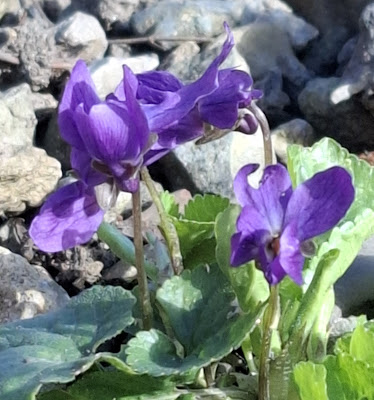It's time for the latest blog from our dedicated team of volunteer gardeners at Pontefract Castle.
Find out more about their blog series here.
17 March 2025
Well, it was another cold start today. While Helen weeded all the planters on site, Dave collected fallen branches from the MHG.
After a bit of selective weeding, Carole relocated some self-seeded golden feverfews and daisies. She then moved them nearer to their parent plants. Carole also planted out some prostrate rosemary cuttings, from last year, on the main wall and the dry-stone wall. They will replace those that had died unexpectedly.
We now have more rhubarb plants for sale along with a tray of columbines (aquilegia).
 |
| Rhubarb plants and columbines for sale on the barrow |
Although it’s not the 'Plant of the Week', the white comfrey is looking remarkably healthy for the time of year.
%20-%20Blog%2011.jpg) |
| The white comfrey bush in the MHG |
Plant of the Week – Violet (viola odorata) Sweet or English Violet
The name 'violet' originates from the Latin 'viola',
which means purple, via the old French 'violette'.
The violet is a perennial plant from Europe and Western Asia. It is rhizomatous, which means it has an underground stem that can produce shoots and roots.
It forms a loose mat of heart-shaped leaves with a height of 15cm and a spread of 30cm. It will tolerate full sun or partial shade, in any type of moist but well-drained soil.
It produces fragrant, violet flowers which are 2cm across. It tends to flower in late Autum and early Spring (although they are a little late this year). They readily self-seed as can be seen in the MHG.
 |
| Violets growing in the Medieval Herb Garden |
Culinary uses of violets
As far back as 1885, a study compared violet leaf vitamin C content to that of oranges and vitamin A content to that of spinach. The leaves, if collected in spring, contain twice as much vitamin C as the same weight of orange. They can also contain more than twice the amount of vitamin A, gram for gram, when compared with spinach.
When newly opened, viola flowers may be used to decorate salads. They can be used in stuffings for poultry or fish. The young leaves are edible, raw or cooked, as a mild-tasting leaf vegetable.
A candied violet is preserved by a coating of egg white and crystallised sugar. Alternatively, hot syrup is poured over the fresh flower and stirred until the sugar recrystallizes and has dried. They are used for decorating cakes or trifles or included in aromatic desserts.
Violet flower vinegar can be used with salads and marinades. Flowers stirred into fresh yogurt and left overnight enhance the taste.
However, care should be taken when using violets for culinary purposes. Over-indulgence can sometimes cause acute stomach upset, high blood pressure, nervousness and breathing problems.
Folklore and other facts about violets
In Greek mythology, Zeus had a lover named Io. In a fit of jealousy, his wife Hera turned her into a white heifer. Zeus created violets to give her something lovely to graze upon.
Violet is the traditional birth flower for February in English tradition. It was Queen Victoria’s favourite flower.
The smell of violets used to be so loved in Britain and France that violet sellers were a common sight on street corners in Spring. People bought little posies for buttonholes and long-stemmed hybrids to put in vases. In 1881, six million bunches of violets were sold in Paris.
In America, there are accounts of Native Americans using violets in cancer treatments.
Medieval uses of violets*
The Ancient Greeks were obsessed with violets. They wore crowns of violets to relieve headaches, cure insomnia, promote sleep and serenity, and stimulate pleasant dreams.
In Macer’s 'Herbal' (10th century) the violet is among the many herbs which were considered powerful against “wykked spirits”.
Violets have been used to make perfume since ancient Greece. They were also used to create early household deodorants in medieval Britain.
According to the herbalist John Gerard in 1597: “The flowers are good for all inflammations, especially of the sides and lungs; they take away the hoarseness of the chest, the ruggedness of the windpipe and jaw, allay the extreme heat of the liver, kidney, and bladder; mitigate the fiery heat of burning agues; temper the sharpness of choler, and take away thirst … Syrup of violets is good against the inflammation of the lungs and breast, against the pleurisy and cough, against fevers and agues in young children.”
*As always, this isn't to be considered medical advice today. Please don't use any plants mentioned in these blogs as medicine without advice from a doctor.

No comments:
Post a Comment
We would love your comments - though they may take a day or two to appear.